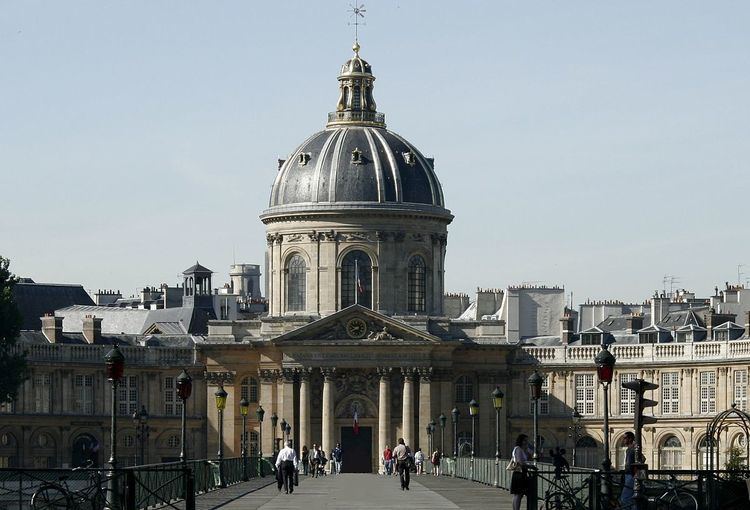The Valz Prize (Prix Valz) was awarded by the French Academy of Sciences, from 1877 through 1970, to honor advances in astronomy.
The Valz Prize was established in June 1874 when the widow of astronomer Benjamin Valz, Marie Madeleine Julie Malhian, donated 10,000 francs to establish a prize in honor of her late husband. The Valz Prize was to be awarded for work of similar stature as that honored by the pre-existing Lalande Prize. The first Valz Prize was awarded in 1877 to brothers Paul and Prosper Henry, and was for the sum of 460 francs.
Save for 1924, the French Academy of Sciences awarded the Valz Prize annually from 1877 to 1943. After 1943, the prize was awarded only sporadically (only once per decade from 1950 to 1970). In 1970 the Valz Prize was combined with the Lalande Prize to create the Lalande-Valz Prize, which continued to be awarded through 1996. In 1997, that prize was combined with numerous other Academy prizes to create the Grande Médaille.
1877 – Paul Henry and Prosper Henry (joint award) – Charts to facilitate search for minor planets1878 – Julius Schmidt – Selenographic work1879 – Étienne Trouvelot – Work on Jupiter, Saturn, and Mars1880 – Wilhelm Tempel – Discovery of twenty comets1881 – David Gill – Work on the determination of the parallax of the Sun1882 – William Huggins – Applications of photography to the study of the spectra of celestial bodies1882 – Luiz Cruls – Spectral studies of the Great Comet of 18821883 – Édouard Jean-Marie Stephan – Discoveries of nebulae1884 – Friedrich Karl Ginzel – Work on the eclipses of the Sun1885 – Friedrich Wilhelm Gustav Spörer – Work on sunspots1886 – Camille Guillaume Bigourdan – Research on the problem of personal error1887 – Ernest Perigaud – Investigation of the meridian instruments of the Paris Observatory1888 – Edward Charles Pickering – Photometric work on stellar magnitude1889 – Auguste Charlois – Astronomical work on orbits of seven asteroids1890 – S. de Glasenapp – Study on the double stars appearing in the Pulkovo Catalog1891 – Hermann Carl Vogel – Research in spectroscopy1892 – Pierre Puiseux – Entirety of his work, including that on the constant of aberration1893 – Adolf Berberich – Calculations of orbits of double stars, comets, and planets1894 – Jean Coniel – Calculations of asteroid orbits1895 – William Frederick Denning – Work on meteors and discoveries of comets1896 – Joseph Bossert – Catalog of 3,950 stars1897 – Louis Fabry – Research on orbits of comets1898 – Élie Colin – Research on astronomy and geodesy, especially latitude1899 – Magnus Nyrén – Sidereal astronomy and observations on the meridian1900 – Aloys Verschaffel – Meridian observations and catalog1901 – Charles André – Treatise on Traite d'Astronomie Stellaire1902 – Ernst Hartwig – Heliometer observations and work on variable stars1903 – Alphonse Borrelly – Discoveries of comets1904 – Campos Rodrigues – Determination of solar parallax by means of the asteroid Eros1905 – Michel Giacobini – discovery of ten comets1906 – Johann Palisa – Entirety of his astronomical research1907 – Michel Giacobini – Astronomical work1908 – Michel Luizet – Work on variable stars1909 – Aymar de la Baume Pluvinel – Entirety of his astronomical work1910 – Stéphane Javelle – Works on nebulae and comets1911 – Charlemagne Rambaud – Astronomical work1912 – Alexandre Schaumasse – Comet discoveries1913 – Alfred Fowler – Work on the principal series of hydrogen lines1914 – Pierre Salet – Research on polarization phenomena1914 – Stanislas Chevalier – Research on the Sun1915 – Armand Lambert – Work as an observer and in applied mathematics1916 – Giovanni Boccardi – Research on variation of latitude; discovery of a sensible inequality in the semi-lunar period1917 – Alexandre Schaumasse – Discovery of comet 1917b (C/1917 H1)1918 – Frédéric Sy – Entirety of his astronomical work1919 – Felix Boquet – Entirety of his scientific work1920 – Ernest Maubant – Calculation of perturbations of Tempel-Swift Comet1921 – Jean Trousset – Research on double stars, the errors of divided circles, and studies of Jupiter's moon, Pasiphae1922 – Jean François Chazy – Papers on the three-body problem1923 – Walter Sydney Adams – Work on Solar and stellar spectroscopy1924 – no award1925 – Vojislav Michkovitch (or Vojislav Mišković) – Work on Stellar statistics1926 – Frank Schlesinger – Astronomical work, especially for work on the stellar parallax1927 – Lucien d'Azambuja – Work on sunspots, solar flares, and the solar chromosphere1928 – George Van Biesbroeck – Entirety of his astronomical work1929 – Louis Dominique Joseph Armand Dunoyer de Segonzac – Research on spirit levels and on photoelectric cells1930 – Gilbert Rougier – Work on photoelectric cells1931 – Henri Chretien – Invention of the anamorphic lens1932 – Jean Dufay – Work on astronomical photometry1933 – Henri Labrouste – Research into periodic solar phenomena1934 – Ferdinand Quenisset – Observations on comets1935 – Raymond Tremblot – For the entirety of his astronomical work1936 – André Couder – Work on optical instruments1937 – Maurice Burgaud – Work in Shanghai, China on terrestrial magnetism1938 – Pierre Lacroute – Work in physical astronomy1938 – Rene Bernard – Work in "the light of the night sky"1940 – Jeanne Clavier – Work on a photographic map of the heavens1941 – Junior Gauzit – Research in physical astronomy1942 – Jean Rösch – Work in physical astronomy1943 – Rose Sainturier (née Rose Bonnet) – Work on double stars1944-1945 – Not awarded1946 – Raoul Goudey – Work on gravity1947-1948 – Not awarded1949 – Jean Delhaye – Work in stellar statistics1950-1958 – Not awarded1959 – Fernan Nahon – Work on stellar statistics and dynamics1960-1968 – Not awarded1969 – André Baranne – Work on optical astronomy1970 – Not awarded
